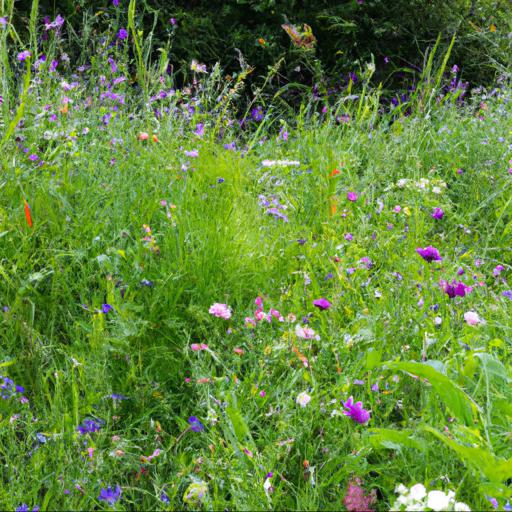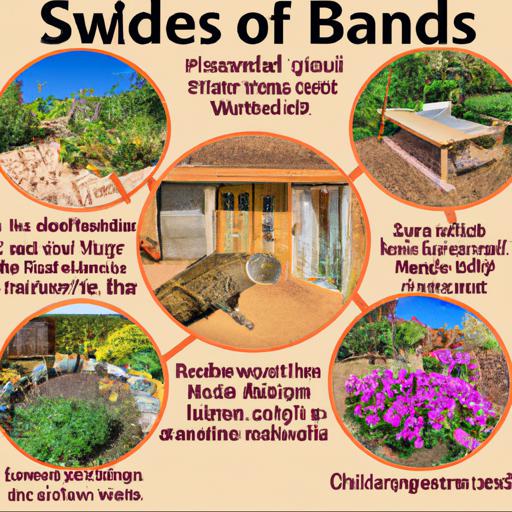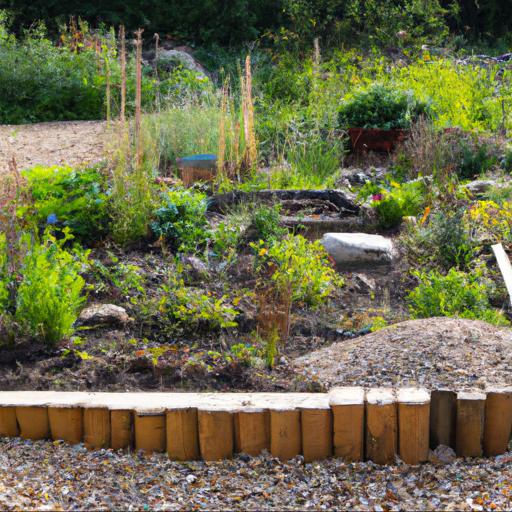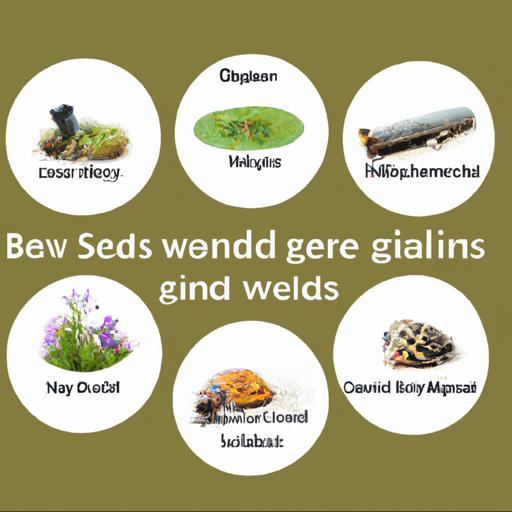Creating a wildlife garden is a great way to bring nature into your backyard. It not only provides a natural habitat for birds and other creatures, but also adds beauty and interest to your outdoor space.
There are six key features to consider when designing a wildlife garden. These include providing food, water, shelter, and nesting sites, as well as choosing native plants and creating a diverse habitat. By incorporating these elements into your garden design, you can create a beautiful and inviting environment that will attract and sustain a variety of wildlife species.
Benefits of wildlife gardens

A wildlife garden is heaven for nature lovers as it provides a safe haven for a variety of animals. People who are passionate about protecting and enhancing the environment can create their very own wildlife garden while at the same time enjoying the magnificent sights and sounds these gardens can bring.
Creating a wildlife garden is not only a wonderful way to bring nature closer to home but also a beneficial way of contributing to the world’s biodiversity. There are a few key elements that must be taken into account when creating a wildlife garden. Six of the most important features of a wildlife garden are food, shelter, water, safe habitats, natural features and weather-proofing.
Firstly, food is essential for all wildlife, which is why it should be a key aspect of the garden. Flowers such as foxgloves, daisies and birdsfoot trefoil can help attract a variety of insects and birds, while bird feeders and bird baths can provide a source of ready food, especially in winter when food sources are limited.
Providing shelter is equally important, as most animals have their own specific requirements. Providing nest boxes, logs or twigs to avoid competition, and hiding places are a great way of providing hospitable housing options. Secondly, water sources are essential for survival and development.
Creating a pond is the perfect way of providing fresh water for wildlife. Ponds offer a variety of benefits such as cooling on hot days and provide habitats for frogs, dragonflies and damselflies.
Edge habitats can also be created by providing rocks and logs, which offer an ideal home for a wide range of species. Thirdly, creating habitats is essential for a wildlife garden as it provides a safe place for animals to nest and feed. A dry, sunny spot can be ideal for solitary bees and other invertebrates, while larger more suitable habitats such as wooded areas make way for different types of wildlife.
Finally, natural features such as trees, shrubs and hedgerows not only provide a source of food and shelter but also act as a much-needed corridor for migrating species. Finally, weather-proofing the garden is imperative in order to protect creatures during extreme weather conditions. Providing sources of food and shelter helps protect wildlife during the winter months, while providing dense cover can provide a much needed break from the wind during summer time. In conclusion, a wildlife garden provides a safe haven for animals while allowing people to enjoy some of the spectacular sights and sounds nature has to offer. By making use of the six key features outlined above, you’ll be able to create the perfect wildlife refuge that will ensure the health and well-being of the local wildlife.
Six key features of a wildlife garden

As a UK gardening expert, I am often asked about the features of a wildlife garden. After all, creating a garden that is not only stunning from an aesthetic standpoint, but also beneficial to the environment is something many of us strive for.
In this blog post, I will share six key features of a wildlife garden, to give you a better idea of what such a garden can look like and how to benefit not only your own space, but the surrounding wildlife too. Firstly, consider the use of native plants. These are sometimes called “indigenous” plants and can be chosen specifically for their ability to attract pollinators and native wildlife.
These can be flowers and shrubs, as well as grasses, trees, and bushes. A great example of a native plant used in wildlife gardens is Buddleia, a hardy perennial shrub that attracts beautiful butterflies. In addition to native plants, a wildlife garden should also feature plenty of feeding areas to provide food sources for wild birds and animals.
Feeders designed for these animals can be placed in or around the garden, and can be re-filled with mixtures of bird seed, suet, or other treats. As water is essential for wildlife, a wildlife garden should have a water feature too.
This could consist of a pond, an outdoor fountain, or even a birdbath. All of these will attract many birds and other creatures, like dragonflies, frogs, and small mammals, who can use the water as a natural source of drinking and bathing. When landscaping a wildlife garden also make sure there is plenty of wildlife-friendly cover.
This could be anything from log piles and rockeries to hedgerow plants and wildflower meadows. Log piles, for example, provide food and shelter for various species, such as toads, hedgehogs, and even slow worms.
In addition to providing food and water sources, it’s important to ensure your wildlife garden also provides shelter for all kinds of animals. To do this, create areas of cover with trellises, shrubs, and other plants. These will provide places for animals to spend the night or provide shade during the heat of the day. Finally, consider creating a compost heap as it’s an easy way to provide organic food sources and aid in nutrient cycling in the garden. Compost piles are also excellent habitats for many invertebrates, like centipedes and beetles. By implementing these six key features of a wildlife garden, not only will you be creating a stunning space that is attractive to the eye, but you’ll also be providing a safe and inviting environment for the local wildlife, At the same time you’ll be helping to ensure the sustainability of the world’s biodiversity.
How to create a wildlife garden

onlyCreating a wildlife garden can be a rewarding pleasure, offering your family and friends, neighbors, and yourself an enjoyable outdoor space. It is possible to construct an environment to attract a variety of wildlife with just a few basic steps.
This article looks into six key features of a wildlife garden that should be taken into account when designing and constructing your garden. Firstly, think of your plot design. If you’re designing a wildlife garden ensure that it includes different habitats and includes a variety of native vegetation.
This could involve both wetland and grassland habitats, and the planting of shrubs, trees, and flowers that attract birds, bugs, and small mammals. This patchwork of habitat should include canopies and denser vegetative layers for wildlife to enjoy and feel safe.
Secondly, water and shelter are of paramount importance in the garden design. If a source of water is available it can be an attraction and a source of revitalization for the area. This means avoiding too steep slopes, which facilitates runoff.
And while a bird bath or water feature can provide a water source, it’s also a great way to add some character to your outdoor space and get your neighbours talking. Shelter can be created through tall vegetation, such as trees and shrubs that attract wildlife and provide enough foliage for birds and small mammals to hide. Thirdly, planting for wildlife should be prioritised over planting for aesthetics and this entails selecting a range of species that the local wildlife loves.
Non-invasive and non-toxic plants should always be chosen to ensure that wildlife is not harmed. Your selection should be made up of native species, which in turn will be rich in nectar and pollen.
A mix of meadow and grassland vegetation is also key and these can include flowers like daisies and poppies. Fourthly, creating piles of tree clippings, old plant material, logs, and branches can offer wildlife a place to hide and hunt for food. It also allows you to create different levels and access points, which acts as a visual stimulation and a fantastic playground for wildlife. Moreover, adding birdhouses or bird boxes in your garden is a great way to entice small birds to your garden and adds a new dimension to your wildlife garden. Fifthly, positioning your garden in a part of the garden with woodland cover is a great way to create a wildlife sanctuary. This way, you create perfect conditions for your wildlife to enjoy, as the woodland will be filled with a variety of vegetation and wildlife, both near and far away. Additionally, to make the most of your wildlife garden, you’ll also need to look after it, as this means managing the space throughout the year, keeping an eye on plant health, and making sure you have enough food and water for the wildlife. And lastly, planting a food crop that’s designed for wildlife is a great way to boost the foraging activity in your garden. Perhaps opt for a single-crop like a sunflower or another annual that’s rich in pollen and nectar and can be grown directly in the soil. Allow the crop to dry and feed it to the wildlife throughout the year. You’ll also need to ensure that your garden is kept clean of any chemicals and pesticides, as these elements can harm the local wildlife. In summary, these are the 6 key features to consider when designing a wildlife garden. With careful planning, thought and consideration, you can turn your outdoor space into a sanctuary for a variety of wild animals. Invite nature into your area and witness its beauty and marvels year-round.
Maintenance of a wildlife garden
As a UK garden expert, I want to provide advice on creating a wildlife garden. A wildlife garden is one that is well-suited to hosting a wide range of wild creatures and plants, both in terms of design and maintenance. When creating a wildlife garden, there are six key features you need to consider to make sure that it is a sustainable habitat for wild animals and plants.
The first feature of a wildlife garden is to plan your space well. You will need to think about how many trees and shrubs you have, and the size and shape of your lawn.
You also need to plan which areas will be sunny, shaded or damp. All these features will determine the species that can thrive in your garden.
The second feature of a wildlife garden is to create a habitat that is suitable for the species that you want to attract. This could be a pond, a wildflower area, a dead wood area, or a bat box. Each species needs a suitable environment in order to survive and breed.
Planning ahead and creating a space that is suitable for a specific species can make it much easier to attract any animals or plants you desire. Third, you need to include a variety of flora and fauna in your garden.
This could be grasses, wildflowers, shrubs and trees. Different species of wildlife will feed on different flowers and plants, so it is important to make sure you have a variety for them to choose from. It is also important that you don’t just have monocultures of species, as this can reduce the diversity of species in the long-term.
Fourth, you need to make sure that your garden is safe and accessible for wild animals. Pesticides, water pumps and water features should be avoided. If you plan to have a pond, it should be placed in a shaded area so that the water stays cool and is less likely to be polluted. A bird bath or stone is an ideal substitute if you don’t have space for a pond. Fifth, you should create a safe refuge, such as log piles, thick hedges and shrubs, for wild animals to hide and nest. Your garden should also be kept free of rubbish and bothersome cats, as these can be a real danger to small mammals and baby birds trying to find shelter. Finally, provide a variety of food for wild animals. You can do this by planting a range of flowers and shrubs, as well as providing bird feeders and water sources. Also, try to limit any disturbances from noise and light, as these can have a negative effect on wildlife. In conclusion, a wildlife garden is one that is specially designed and maintained to provide a habitat for wildlife. With careful planning and consideration of the six key features outlined above, you will be able to create a wildlife garden that is attractive to a diverse range of animals and plants. In no time at all, you’ll be able to witness nature in all its glory in your own back garden.
Final Touch
A wildlife garden is a great way to bring nature into your backyard. It provides a habitat for birds, insects, and other animals.
Six key features of a wildlife garden include native plants, water sources, nesting boxes, food sources, shelter, and natural materials. By incorporating these elements into your garden, you can help create an inviting and sustainable environment for wildlife.
FAQ
What plants are best suited for a wildlife garden?
Native plants are best suited for a wildlife garden because they provide food and shelter for local wildlife.
How can I attract birds to my wildlife garden?
To attract birds to your wildlife garden, you can provide food, water, and shelter. Plant native plants that provide food and shelter, such as shrubs, trees, and flowering plants. Install bird feeders, bird baths, and bird houses. Avoid using pesticides and keep cats away from the garden.
What other animals can I expect to see in my wildlife garden?
The types of animals you can expect to see in your wildlife garden will depend on the type of habitat you create. Common animals that may visit your garden include birds, butterflies, bees, hedgehogs, frogs, toads, and small mammals such as squirrels and chipmunks.
What type of water feature should I include in my wildlife garden?
The type of water feature you should include in your wildlife garden depends on the size and layout of your garden, as well as the types of wildlife you would like to attract. Some popular water features for wildlife gardens include birdbaths, ponds, waterfalls, and streams.
How can I make my wildlife garden more inviting to wildlife?
To make your wildlife garden more inviting to wildlife, you can add native plants that provide food and shelter, create a water source, provide nesting and roosting spots, and limit the use of pesticides and other chemicals.
What type of soil is best for a wildlife garden?
Organic, well-draining soil is best for a wildlife garden.

